中考英语语法精讲精练系列---形容词、副词讲解
文档属性
| 名称 | 中考英语语法精讲精练系列---形容词、副词讲解 |  | |
| 格式 | pptx | ||
| 文件大小 | 19.9MB | ||
| 资源类型 | 教案 | ||
| 版本资源 | 通用版 | ||
| 科目 | 英语 | ||
| 更新时间 | 2024-11-26 15:28:25 | ||
图片预览

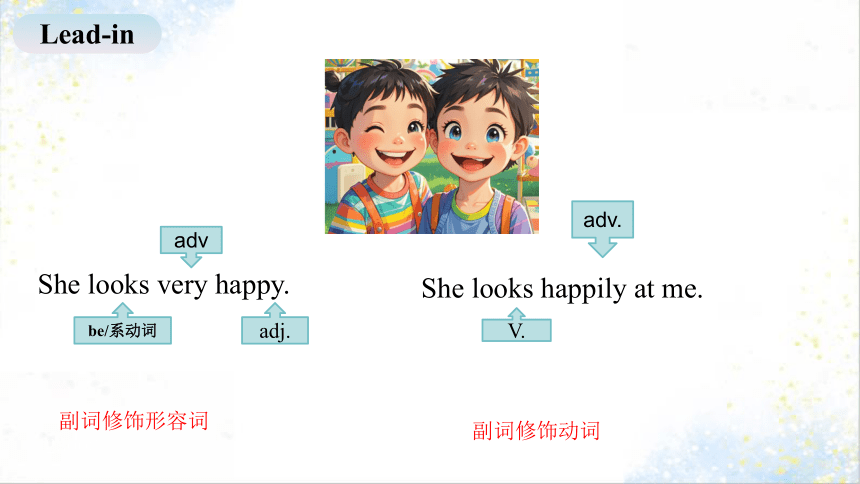

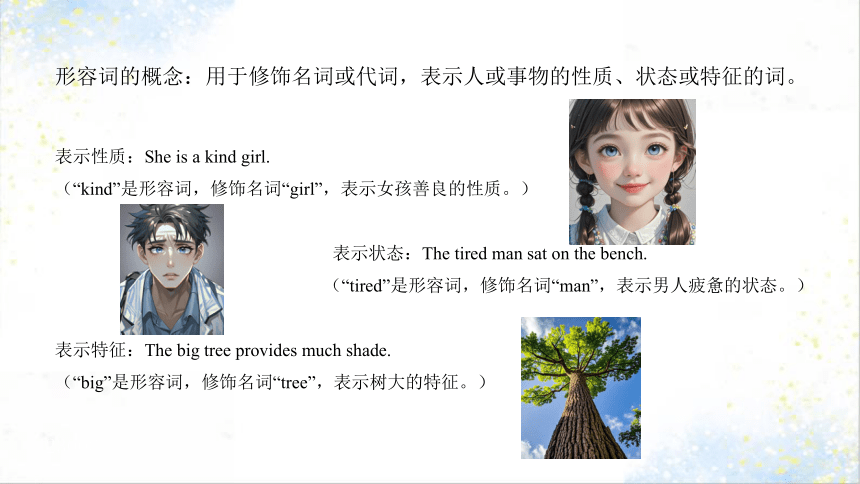

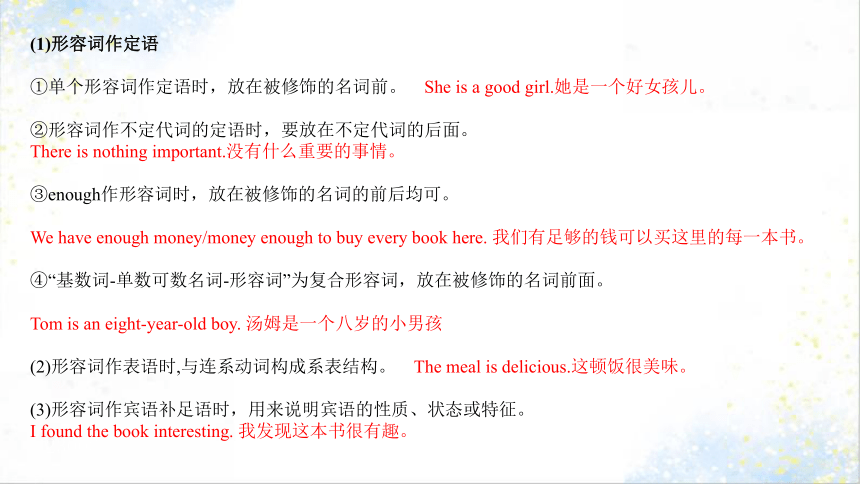
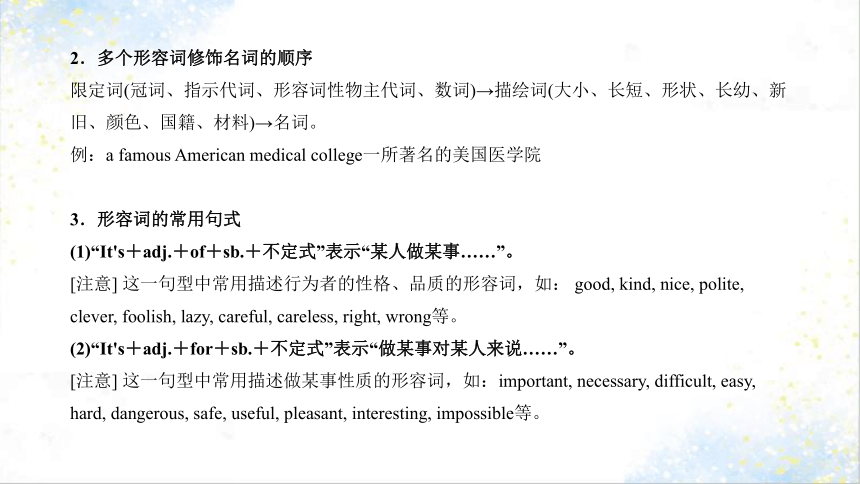
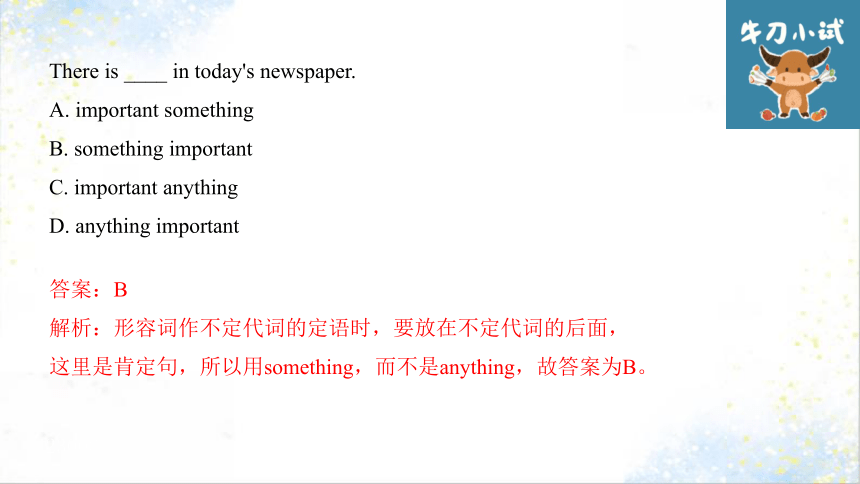
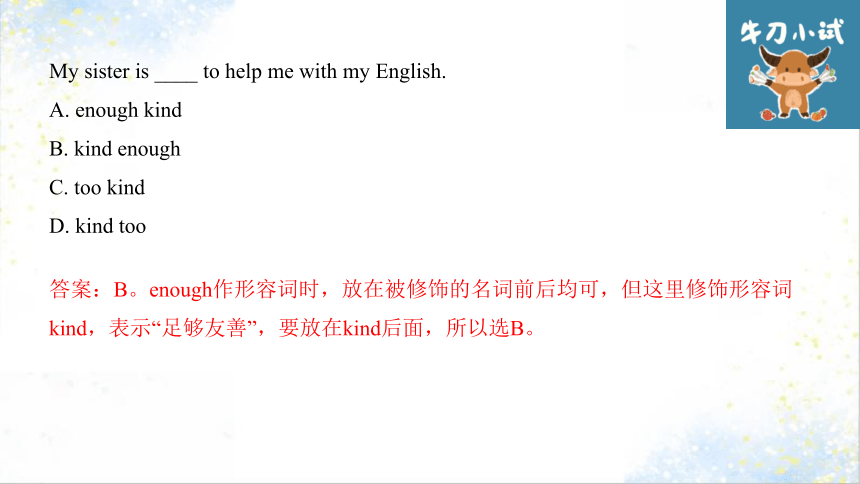
文档简介
(共27张PPT)
中考英语语法
精讲精练系列
(四)形容词、副词
Lead-in
She looks very happy.
She looks happily at me.
be/系动词
adv
adj.
副词修饰形容词
副词修饰动词
V.
adv.
形容词的概念
形容词的概念:用于修饰名词或代词,表示人或事物的性质、状态或特征的词。
表示性质:She is a kind girl.
(“kind”是形容词,修饰名词“girl”,表示女孩善良的性质。)
表示状态:The tired man sat on the bench.
(“tired”是形容词,修饰名词“man”,表示男人疲惫的状态。)
表示特征:The big tree provides much shade.
(“big”是形容词,修饰名词“tree”,表示树大的特征。)
形容词的功能
(1)形容词作定语
①单个形容词作定语时,放在被修饰的名词前。 She is a good girl.她是一个好女孩儿。
②形容词作不定代词的定语时,要放在不定代词的后面。
There is nothing important.没有什么重要的事情。
③enough作形容词时,放在被修饰的名词的前后均可。
We have enough money/money enough to buy every book here. 我们有足够的钱可以买这里的每一本书。
④“基数词 单数可数名词 形容词”为复合形容词,放在被修饰的名词前面。
Tom is an eight year old boy. 汤姆是一个八岁的小男孩
(2)形容词作表语时,与连系动词构成系表结构。 The meal is delicious.这顿饭很美味。
(3)形容词作宾语补足语时,用来说明宾语的性质、状态或特征。
I found the book interesting. 我发现这本书很有趣。
2.多个形容词修饰名词的顺序
限定词(冠词、指示代词、形容词性物主代词、数词)→描绘词(大小、长短、形状、长幼、新旧、颜色、国籍、材料)→名词。
例:a famous American medical college一所著名的美国医学院
3.形容词的常用句式
(1)“It's+adj.+of+sb.+不定式”表示“某人做某事……”。
[注意] 这一句型中常用描述行为者的性格、品质的形容词,如: good, kind, nice, polite, clever, foolish, lazy, careful, careless, right, wrong等。
(2)“It's+adj.+for+sb.+不定式”表示“做某事对某人来说……”。
[注意] 这一句型中常用描述做某事性质的形容词,如:important, necessary, difficult, easy, hard, dangerous, safe, useful, pleasant, interesting, impossible等。
There is ____ in today's newspaper.
A. important something
B. something important
C. important anything
D. anything important
答案:B
解析:形容词作不定代词的定语时,要放在不定代词的后面,这里是肯定句,所以用something,而不是anything,故答案为B。
My sister is ____ to help me with my English.
A. enough kind
B. kind enough
C. too kind
D. kind too
答案:B。enough作形容词时,放在被修饰的名词前后均可,但这里修饰形容词kind,表示“足够友善”,要放在kind后面,所以选B。
____ is very kind of you to help the old man cross the road.
A. This
B. It
C. That
D. He
答案:B。
解析:“It's+adj.+of+sb.+不定式”是固定句型,表示“某人做某事……”,这里it是形式主语,真正的主语是后面的不定式“to help the old man cross the road”,所以选B。
副词的概念
副词的概念
副词的概念:副词的概念:主要用于修饰动词、形容词、其他副词或句子,用于说明时间、地点、程度或方式等。
修饰动词
She often goes to the park.
(“often”是副词,修饰动词“goes”,
说明去公园这个动作发生的频率,是时间方面的概念。)
He ran downstairs quickly.
(“downstairs”是副词,修饰动词“ran”,说明跑这个动作发生的地点。)
The boy reads loudly.
(“loudly”是副词,修饰动词“reads”,说明读这个动作的方式。)
二、修饰形容词
说明程度:This book is very interesting.
(“very”是副词,修饰形容词“interesting”,说明有趣的程度。)
三、修饰其他副词
She drives extremely fast.
(“extremely”是副词,修饰副词“fast”,进一步说明快的程度。)
四、修饰句子
Fortunately, we got home before the rain started.
(“Fortunately”是副词,修饰整个句子,表示一种幸运的情况。)
We should study ____ for the exam.
A. hard
B. hardly
C. harder
D. hardliest
答案:A
解析:这里需要一个副词来修饰动词“study”,表示学习的程度。“hard”表示“努力地”,是副词;“hardly”表示“几乎不”,不符合题意;“harder”是“hard”的比较级,这里没有比较的语境;“hardliest”这种形式不存在。根据“副词通常放在被修饰的动词后面”,所以选A。
She ____ has finished her work.
A. already
B. all ready
C. yet
D. still
答案:A
解析:句中“has”是助动词,根据“句中有多个助动词时,副词一般放在第一个助动词后”,这里需要一个副词放在“has”后面。“already”是副词,表示“已经”,符合题意;“all ready”是“所有都准备好”,是形容词短语;“yet”通常用于否定句或疑问句;“still”虽然也是副词,但放在这里语义不如“already”合适,所以选A。
形容词和副词
的比较等级
1. 规则变化
(1)一般在词尾直接加-er或-est。
如: tall—taller—tallest,
long—longer—longest
(2)以不发音的字母e结尾的单词在词尾直接加-r或-st。
如: nice—nicer—nicest,
large—larger—largest
more beautiful—most beautiful
(3)以“辅音字母+y”结尾的词,把y变为i,再加-er或-est
如: heavy—heavier—heaviest,
busy—busier—busiest,
funny—funnier—funniest
(4)在重读闭音节中,若末尾只有一个辅音字母,则双写这个辅音字母,再加-er或-est。
如: big—bigger—biggest,
hot—hotter—hottest,
thin—thinner —thinnest,
fat—fatter—fattest
(5)部分双音节词和多音节词分别在原级前加more构成比较级,加most构成最高级。
如:slowly—more slowly —most slowly, beautiful———more beautiful—most beautiful
2.不规则变化
good/well—better—best many/much—more—most ill/bad/badly—worse—worst
little—less—least far—farther/further—farthest/furthest
Which is the ____ word in this sentence
A. long
B. longer
C. longest
D. the long
答案:C
解析:这里是问这个句子里最长的单词,在形容词“long”的规则变化中,最高级形式是“longest”,用于三者或三者以上的比较,所以选C。
He runs ____ than his brother.
A. fast
B. faster
C. more fast
D. most fast
答案:B。
解析:根据题意是他比他哥哥跑得更快,“fast”是单音节词,其比较级是在词尾直接加 -er,即“faster”,而“more fast”和“most fast”形式错误,“fast”本身是原级,不符合比较的语境,所以选B。
形容词和副词
比较等级的用法
1.原级的用法
(1)只能修饰原级的词有very, quite, so, too等。
The old man is too tired to walk on. 那位老人太累了不能再继续走了。
(2)原级常用的句型结构
①“A+v.+as+形容词/副词原级+as+B”
表示“A和B程度相同”
例:Lucy is as old as Kate. 露西和凯特的年龄一样大。
Tom runs as quickly as Mike.汤姆和迈克跑得一样快。
②“ A+v.+not+as/so+形容词/副词原级+as+B” 表示“A不如B……”。
如:This classroom is not as /so big as that one. 这间教室不如那间大。
He doesn't walk as slowly as you. 他走路不像你那样慢。
2.比较级常用的句型结构
(1)“A+v.+比较级+than+any other+单数名词(+介词短语)”表示“A比同一范围内的任何一个人/物都……”,含义是“A最……”。
Xiaoming is taller than any other boy in his class.
=Xiaoming is taller than(any of)the other boys in his class.小明比他班上的其他任何男孩都高。
=Xiaoming is the tallest boy in his class. 小明是他班上最高的男孩。
(2)“A+v.+the+比较级+of the two+……”表示“A是两者中较……的”。
Look at the two boys. Xiaoming is the taller of the two. 看那两个男孩,小明是两个当中较高的那个。
(3)“比较级+and+比较级”表示“越来越……”。
He is getting taller and taller .他越来越高了。
He does his homework more and more carefully. 他做作业越来越认真了。
(4)“the+比较级,the+比较级”表示“越……,就越……”。
The harder you work,the better your grades will be.
你越努力学习,你的成绩就会越好。
(5)“特殊疑问词+v.+比较级,A or B?”
Which is bigger, the blue ball or the red one 哪一个球更大,蓝球还是红球?
[注意] 比较级前常用much, even, a little, a bit, a lot, far等词修饰。
3.最高级常用句型结构
(1)“主语+v.+the+最高级+(单数可数名词)+in/of短语”表示“……是……中最……的”。
如:Tom is the tallest (student) in his class. 汤姆是他们班上最高的(学生)。
I jump (the farthest) in my class.我是我们班跳得最远的。
(2)“主语+v.+one of the+最高级+复数可数名词+in/of短语”表示“……是……中最……之一”。
Beijing is one of the biggest cities in China. 北京是中国最大的城市之一。
(3)“特殊疑问词+v.+the+最高级,A,B,or C?”用于三者以上的人或物的比较。
Which season do you like best/(the) most, spring, summer or autumn 你最喜欢哪一个季节,春天,夏天还是秋天?
(4)“主语+v.+the+序数词+最高级+单数可数名词+in/of短语”表示“……是……中的第几……”。
Tom is the second tallest boy in his class.汤姆是他们班第二高的男生
My sister is ____ as tall as my mother.
A. very
B. quite
C. so
D. as
答案:D
解析: 根据原级的句型结构“A+v.+as+形容词/副词原级+as+B”,这里需要“as”来表示“和……一样”,而“very”“quite”“so”虽然能修饰原级,但不用于这个句型结构,所以选D。
Among the three books, this one is ____.
A. the more interesting
B. the most interesting
C. more interesting
D. most interesting
答案:B
解析:根据最高级的句型结构“主语+v.+the+最高级+(单数可数名词)+in/of短语”,这里是在三本书当中比较,要用最高级,“interesting”是多音节词,其最高级形式是“the most interesting”,“the more interesting”是比较级形式,“more interesting”缺少“the”,“most interesting”也缺少“the”,所以选B。
中考英语语法
精讲精练系列
(四)形容词、副词
Lead-in
She looks very happy.
She looks happily at me.
be/系动词
adv
adj.
副词修饰形容词
副词修饰动词
V.
adv.
形容词的概念
形容词的概念:用于修饰名词或代词,表示人或事物的性质、状态或特征的词。
表示性质:She is a kind girl.
(“kind”是形容词,修饰名词“girl”,表示女孩善良的性质。)
表示状态:The tired man sat on the bench.
(“tired”是形容词,修饰名词“man”,表示男人疲惫的状态。)
表示特征:The big tree provides much shade.
(“big”是形容词,修饰名词“tree”,表示树大的特征。)
形容词的功能
(1)形容词作定语
①单个形容词作定语时,放在被修饰的名词前。 She is a good girl.她是一个好女孩儿。
②形容词作不定代词的定语时,要放在不定代词的后面。
There is nothing important.没有什么重要的事情。
③enough作形容词时,放在被修饰的名词的前后均可。
We have enough money/money enough to buy every book here. 我们有足够的钱可以买这里的每一本书。
④“基数词 单数可数名词 形容词”为复合形容词,放在被修饰的名词前面。
Tom is an eight year old boy. 汤姆是一个八岁的小男孩
(2)形容词作表语时,与连系动词构成系表结构。 The meal is delicious.这顿饭很美味。
(3)形容词作宾语补足语时,用来说明宾语的性质、状态或特征。
I found the book interesting. 我发现这本书很有趣。
2.多个形容词修饰名词的顺序
限定词(冠词、指示代词、形容词性物主代词、数词)→描绘词(大小、长短、形状、长幼、新旧、颜色、国籍、材料)→名词。
例:a famous American medical college一所著名的美国医学院
3.形容词的常用句式
(1)“It's+adj.+of+sb.+不定式”表示“某人做某事……”。
[注意] 这一句型中常用描述行为者的性格、品质的形容词,如: good, kind, nice, polite, clever, foolish, lazy, careful, careless, right, wrong等。
(2)“It's+adj.+for+sb.+不定式”表示“做某事对某人来说……”。
[注意] 这一句型中常用描述做某事性质的形容词,如:important, necessary, difficult, easy, hard, dangerous, safe, useful, pleasant, interesting, impossible等。
There is ____ in today's newspaper.
A. important something
B. something important
C. important anything
D. anything important
答案:B
解析:形容词作不定代词的定语时,要放在不定代词的后面,这里是肯定句,所以用something,而不是anything,故答案为B。
My sister is ____ to help me with my English.
A. enough kind
B. kind enough
C. too kind
D. kind too
答案:B。enough作形容词时,放在被修饰的名词前后均可,但这里修饰形容词kind,表示“足够友善”,要放在kind后面,所以选B。
____ is very kind of you to help the old man cross the road.
A. This
B. It
C. That
D. He
答案:B。
解析:“It's+adj.+of+sb.+不定式”是固定句型,表示“某人做某事……”,这里it是形式主语,真正的主语是后面的不定式“to help the old man cross the road”,所以选B。
副词的概念
副词的概念
副词的概念:副词的概念:主要用于修饰动词、形容词、其他副词或句子,用于说明时间、地点、程度或方式等。
修饰动词
She often goes to the park.
(“often”是副词,修饰动词“goes”,
说明去公园这个动作发生的频率,是时间方面的概念。)
He ran downstairs quickly.
(“downstairs”是副词,修饰动词“ran”,说明跑这个动作发生的地点。)
The boy reads loudly.
(“loudly”是副词,修饰动词“reads”,说明读这个动作的方式。)
二、修饰形容词
说明程度:This book is very interesting.
(“very”是副词,修饰形容词“interesting”,说明有趣的程度。)
三、修饰其他副词
She drives extremely fast.
(“extremely”是副词,修饰副词“fast”,进一步说明快的程度。)
四、修饰句子
Fortunately, we got home before the rain started.
(“Fortunately”是副词,修饰整个句子,表示一种幸运的情况。)
We should study ____ for the exam.
A. hard
B. hardly
C. harder
D. hardliest
答案:A
解析:这里需要一个副词来修饰动词“study”,表示学习的程度。“hard”表示“努力地”,是副词;“hardly”表示“几乎不”,不符合题意;“harder”是“hard”的比较级,这里没有比较的语境;“hardliest”这种形式不存在。根据“副词通常放在被修饰的动词后面”,所以选A。
She ____ has finished her work.
A. already
B. all ready
C. yet
D. still
答案:A
解析:句中“has”是助动词,根据“句中有多个助动词时,副词一般放在第一个助动词后”,这里需要一个副词放在“has”后面。“already”是副词,表示“已经”,符合题意;“all ready”是“所有都准备好”,是形容词短语;“yet”通常用于否定句或疑问句;“still”虽然也是副词,但放在这里语义不如“already”合适,所以选A。
形容词和副词
的比较等级
1. 规则变化
(1)一般在词尾直接加-er或-est。
如: tall—taller—tallest,
long—longer—longest
(2)以不发音的字母e结尾的单词在词尾直接加-r或-st。
如: nice—nicer—nicest,
large—larger—largest
more beautiful—most beautiful
(3)以“辅音字母+y”结尾的词,把y变为i,再加-er或-est
如: heavy—heavier—heaviest,
busy—busier—busiest,
funny—funnier—funniest
(4)在重读闭音节中,若末尾只有一个辅音字母,则双写这个辅音字母,再加-er或-est。
如: big—bigger—biggest,
hot—hotter—hottest,
thin—thinner —thinnest,
fat—fatter—fattest
(5)部分双音节词和多音节词分别在原级前加more构成比较级,加most构成最高级。
如:slowly—more slowly —most slowly, beautiful———more beautiful—most beautiful
2.不规则变化
good/well—better—best many/much—more—most ill/bad/badly—worse—worst
little—less—least far—farther/further—farthest/furthest
Which is the ____ word in this sentence
A. long
B. longer
C. longest
D. the long
答案:C
解析:这里是问这个句子里最长的单词,在形容词“long”的规则变化中,最高级形式是“longest”,用于三者或三者以上的比较,所以选C。
He runs ____ than his brother.
A. fast
B. faster
C. more fast
D. most fast
答案:B。
解析:根据题意是他比他哥哥跑得更快,“fast”是单音节词,其比较级是在词尾直接加 -er,即“faster”,而“more fast”和“most fast”形式错误,“fast”本身是原级,不符合比较的语境,所以选B。
形容词和副词
比较等级的用法
1.原级的用法
(1)只能修饰原级的词有very, quite, so, too等。
The old man is too tired to walk on. 那位老人太累了不能再继续走了。
(2)原级常用的句型结构
①“A+v.+as+形容词/副词原级+as+B”
表示“A和B程度相同”
例:Lucy is as old as Kate. 露西和凯特的年龄一样大。
Tom runs as quickly as Mike.汤姆和迈克跑得一样快。
②“ A+v.+not+as/so+形容词/副词原级+as+B” 表示“A不如B……”。
如:This classroom is not as /so big as that one. 这间教室不如那间大。
He doesn't walk as slowly as you. 他走路不像你那样慢。
2.比较级常用的句型结构
(1)“A+v.+比较级+than+any other+单数名词(+介词短语)”表示“A比同一范围内的任何一个人/物都……”,含义是“A最……”。
Xiaoming is taller than any other boy in his class.
=Xiaoming is taller than(any of)the other boys in his class.小明比他班上的其他任何男孩都高。
=Xiaoming is the tallest boy in his class. 小明是他班上最高的男孩。
(2)“A+v.+the+比较级+of the two+……”表示“A是两者中较……的”。
Look at the two boys. Xiaoming is the taller of the two. 看那两个男孩,小明是两个当中较高的那个。
(3)“比较级+and+比较级”表示“越来越……”。
He is getting taller and taller .他越来越高了。
He does his homework more and more carefully. 他做作业越来越认真了。
(4)“the+比较级,the+比较级”表示“越……,就越……”。
The harder you work,the better your grades will be.
你越努力学习,你的成绩就会越好。
(5)“特殊疑问词+v.+比较级,A or B?”
Which is bigger, the blue ball or the red one 哪一个球更大,蓝球还是红球?
[注意] 比较级前常用much, even, a little, a bit, a lot, far等词修饰。
3.最高级常用句型结构
(1)“主语+v.+the+最高级+(单数可数名词)+in/of短语”表示“……是……中最……的”。
如:Tom is the tallest (student) in his class. 汤姆是他们班上最高的(学生)。
I jump (the farthest) in my class.我是我们班跳得最远的。
(2)“主语+v.+one of the+最高级+复数可数名词+in/of短语”表示“……是……中最……之一”。
Beijing is one of the biggest cities in China. 北京是中国最大的城市之一。
(3)“特殊疑问词+v.+the+最高级,A,B,or C?”用于三者以上的人或物的比较。
Which season do you like best/(the) most, spring, summer or autumn 你最喜欢哪一个季节,春天,夏天还是秋天?
(4)“主语+v.+the+序数词+最高级+单数可数名词+in/of短语”表示“……是……中的第几……”。
Tom is the second tallest boy in his class.汤姆是他们班第二高的男生
My sister is ____ as tall as my mother.
A. very
B. quite
C. so
D. as
答案:D
解析: 根据原级的句型结构“A+v.+as+形容词/副词原级+as+B”,这里需要“as”来表示“和……一样”,而“very”“quite”“so”虽然能修饰原级,但不用于这个句型结构,所以选D。
Among the three books, this one is ____.
A. the more interesting
B. the most interesting
C. more interesting
D. most interesting
答案:B
解析:根据最高级的句型结构“主语+v.+the+最高级+(单数可数名词)+in/of短语”,这里是在三本书当中比较,要用最高级,“interesting”是多音节词,其最高级形式是“the most interesting”,“the more interesting”是比较级形式,“more interesting”缺少“the”,“most interesting”也缺少“the”,所以选B。
同课章节目录
- 词法
- 名词
- 动词和动词短语
- 动词语态
- 动词时态
- 助动词和情态动词
- 非谓语动词
- 冠词
- 代词
- 数词和量词
- 形容词副词及其比较等级
- 介词和介词短语
- 连词和感叹词
- 构词法
- 相似、相近词比较
- 句法
- 陈述句
- 一般疑问句和否定疑问句
- 特殊疑问句及选择疑问句
- 反意疑问句
- 存在句(There be句型)
- 宾语从句
- 定语从句
- 状语从句
- 主谓一致问题
- 简单句
- 并列句
- 复合句
- 主谓一致
- 主、表语从句
- 名词性从句
- 直接引语和间接引语
- 虚拟语气
- 感叹句
- 强调句
- 倒装句
- 祈使句
- 句子的成分
- 句子的分类
- 题型专区
- 单项选择部分
- 易错题
- 完形填空
- 阅读理解
- 词汇练习
- 听说训练
- 句型转换
- 补全对话
- 短文改错
- 翻译
- 书面表达
- 任务型阅读
- 语法填空
- 其他资料
